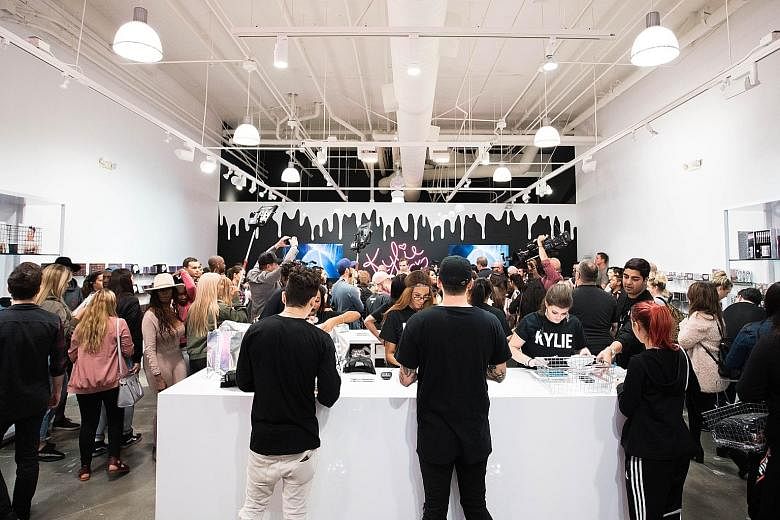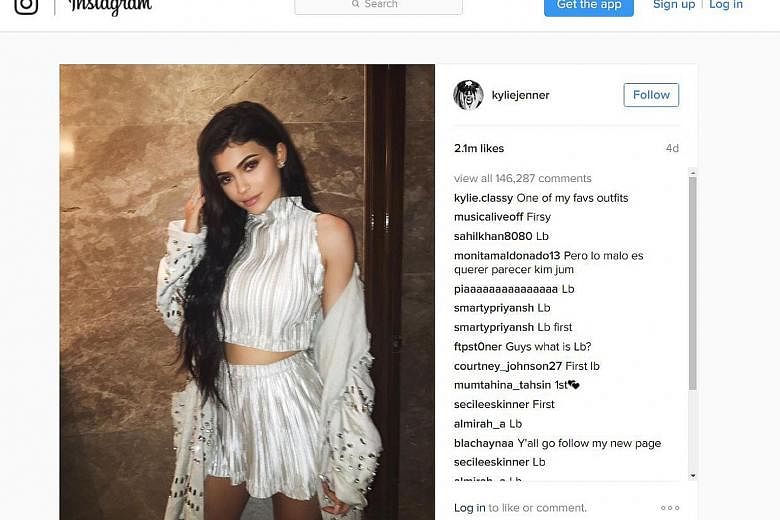NEW YORK • On Dec 9, a sunny morning, chaos descended upon a glossy shopping mall in the Canoga Park section of Los Angeles.
Thousands of young women (and a few men), many of whom had slept in the parking lot of the Westfield Topanga mall overnight or travelled from several states away, surged en masse at 10am towards a monochrome, recently erected temporary store on the first floor.
Hours later, most shoppers were still there, waiting in snaking lines and shrieking intermittently. Others, their eyes downcast, tapped on smartphones.
The reason for the mall mania? The unveiling of the Kylie Pop-Up Shop, the first IRL (in real life) retail venture from Kylie Jenner, the pouting 19-year-old reality-TV star whose Snapchat-led marketing of her eponymous Kylie Cosmetics line has become a recent e-tail phenomenon.
"The empire, it's all for you," Jenner said as she arrived to open her store, part of which she designed by taking inspiration from the bedroom of her mansion in Calabasas, California. (Imagine a gigantic bed with white sheets, a pink neon autograph on black walls and a video installation of Jenner in lingerie and a fur coat rolling around in bed with her rapper boyfriend Tyga.)
She waved and blew kisses - the scene was streamed on Snapchat - before taking a few selfies with fans. Pandemonium ensued.
Over the past 13 months, the youngest member of the Kardashian/Jenner clan has built a business empire for herself, with an estimated US$10 million (S$14.4 million) in personal earnings from sales of branded merchandise, which ranges from Kylie Lip Kits (pairs of matte liquid lipstick and lip liner that retail for US$29) to Kyshadows and Kyliners (eye shadows and eye liners) in a multitude of colours and themes.
She offers them exclusively on her website in limited timeframes for as long as stocks last.
Appetites are stoked to near fever pitch by video clips of Jenner applying the cosmetics or giving tutorials using them. Those clips are posted to Snapchat, with hints dropped on Twitter or Instagram as to when these products may be available.
Although no one knows exactly how many followers she has, a spokesman for Snapchat said in August that Jenner was the most followed person on the platform.
So when the latest batch of new stock does go live on her website, all products are sold, on average, in less than a minute. Then the process begins again.
Jenner is part of a growing cohort of both individuals and brands who have embraced the sales strategy known as the "drop".
It works like this: A seller controls the release of exclusive new items outside the traditional fashion cycle, cleverly marketing the impending arrival of the product to build demand.
Pioneered almost two decades ago by American skatewear brand Supreme, which took its cues from the Japanese streetwear scene, the trend has gained particular momentum in recent years, thanks to its adoption by some in the booming limited-edition sneaker industry: Kanye West's Yeezy line with Adidas, for example, and Nike's Air Jordans.
It is also at the heart of the limited-edition designer collaborations championed by retailers such as H&M and Target.
Even Snapchat tried to jump on the bandwagon last month when it began exclusive sales of its new Spectacles glasses via randomly placed bright yellow vending machines, giving no indication of where they would crop up next. The overwhelming majority of drop customers, whatever the product, are younger than 30.
"In the e-commerce age, older consumers have shown that they want ease, convenience and plenty of variety from their shopping experience," said Mr Avery Booker, chief executive of Enflux, a digital influence-mining tool. But, he said, when it comes to Generation Z, those born in the years from the mid-1990s to the early 2000s, and the younger millennials, "in many cases the opposite is emerging". "They are excited not just by a product's rarity," he continued, "but also by what credibility owning that product can give them within their social media communities, as well as its possible resale value."
The flourishing secondary markets, fuelled by online resellers and prompted by the growing clout of drop culture, has been one of the most significant changes to the retail landscape in recent years.
Mere hours after the latest Kylie Lip Kit, Supreme sneaker or H&M/Alexander Wang piece has sold out on official distribution channels, these items are often available elsewhere on the Internet, though with one or more zeros added to the price.
For savvier fans, the use of auto-fillers or bots to skip the digital lines for valuable items is increasing.
Some independent businesses are also recognising new opportunities to profit and are building new services accordingly.
Depop, which was started in Britain in 2012, is a buying, selling and swopping app for clothes, accessories and other wares. It created communities of influencers and like-minded shoppers and has strong roots in the resale market. Eighty per cent of its user base is under 30.
"Brands such as Supreme and Palace really understand successful 21st-century branding and how to appeal to younger consumers from the selfie generation," said Ms Maria Raga, chief executive of Depop. "There is no question that our business is capitalising on their success. Many of the most successful resellers to emerge out of the drop culture don't just see what they do as a way of making money. They see it as a way of building their own brand. They can gain huge profiles and followings in their own right."
It is not necessarily in their nature to save the earnings from transactions either. "To keep up their social media credentials, Generation Z feel they need to change their clothing much quicker than shoppers in their late 20s upwards," Ms Raga said. "Plus there is always a hot new pricey brand on the up. Most of them are students. They aren't really earning money yet. So to buy more, they need to keep selling stuff."
Charles Fitchew, a 13-year-old in Manchester, England, is one example. He said he did 95 per cent of his shopping online, with the traditional majority of any new purchases coming from drops.
Lately, however, he said a growing number now came from transactions that took place on Facebook messenger chat groups, particularly for sneaker resales.
"These days, if you want the coolest stuff you have three options," he said. "You can queue up overnight outside a store before a drop or hope for the best online. You can go to an established site if you miss out or can't be bothered to wait, but expect to pay double the original price. Or you can go on Snapchat or a Facebook Talk group, get a better bargain and really be able to ask questions about the quality and condition of what's being sold.
"If it isn't up to scratch, then the seller gets kicked out by the rest of the community," he added. "That's how things work at our age. The best things should never be easy to get, otherwise what's their value?"
NYTIMES


